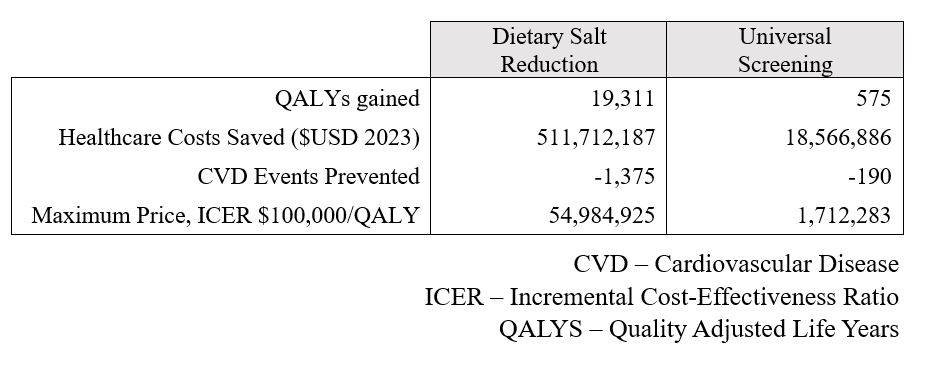Final ID: P3152
Cost-Effectiveness of Dietary Salt Reduction and Universal Screening Programs to Control Hypertension in US Young Adults
Abstract Body: Introduction
Almost half of US young adults (aged 18-39 years) have hypertension. This is due to a high prevalence of risk factors, including the fact that most young adults exceed recommended daily sodium intake, alongside underdiagnosis and undertreatment. Cumulative exposure to elevated blood pressure (BP) in young adulthood increases later life risk of cardiovascular disease (CVD), so interventions that reduce BP levels in this age-group could improve population health.
Objective
We aimed to estimate the cost and health-related quality of life benefits of two interventions at different points in the pathway of hypertension control in young adults: reducing dietary salt intake (to reduce HTN incidence) and increasing BP screening rates (to increase diagnosis and treatment).
Methods
The CVD Policy Model, an established computer simulation model, estimated lifetime costs and quality-adjusted life years (QALYs) associated with BP-reducing interventions in a cohort of 100,000 US young adults. Risk of CVD events in the model was determined by a range of CVD risk factors, including cumulative exposure to systolic BP throughout the lifecourse. We modelled two hypothetical interventions: a population-level policy that reduces average sodium consumption by 1 g/day and an annual hypertension screening program for all young adults. We estimated the maximum price at which each intervention would be cost-effective (incremental cost-effectiveness ratio [ICER] less than $100,000/QALY) compared to usual care.
Results
In a cohort of 100,000 US young adults, reducing dietary salt consumption by 1 g/day would produce around 19,300 QALYs and prevent around 1,400 CVD events over a lifetime horizon. For policymakers, it would be cost-effective to invest up to $55 million ($550 per young adult) to achieve this reduction in salt intake. Universal screening would also improve health outcomes (575 QALYs gained, 190 CVD events prevented), but the maximum cost-effective price for this policy was much lower ($17 per young adult).
Conclusion
Reducing incidence and improving treatment of hypertension in young adulthood could improve population health substantially.
Almost half of US young adults (aged 18-39 years) have hypertension. This is due to a high prevalence of risk factors, including the fact that most young adults exceed recommended daily sodium intake, alongside underdiagnosis and undertreatment. Cumulative exposure to elevated blood pressure (BP) in young adulthood increases later life risk of cardiovascular disease (CVD), so interventions that reduce BP levels in this age-group could improve population health.
Objective
We aimed to estimate the cost and health-related quality of life benefits of two interventions at different points in the pathway of hypertension control in young adults: reducing dietary salt intake (to reduce HTN incidence) and increasing BP screening rates (to increase diagnosis and treatment).
Methods
The CVD Policy Model, an established computer simulation model, estimated lifetime costs and quality-adjusted life years (QALYs) associated with BP-reducing interventions in a cohort of 100,000 US young adults. Risk of CVD events in the model was determined by a range of CVD risk factors, including cumulative exposure to systolic BP throughout the lifecourse. We modelled two hypothetical interventions: a population-level policy that reduces average sodium consumption by 1 g/day and an annual hypertension screening program for all young adults. We estimated the maximum price at which each intervention would be cost-effective (incremental cost-effectiveness ratio [ICER] less than $100,000/QALY) compared to usual care.
Results
In a cohort of 100,000 US young adults, reducing dietary salt consumption by 1 g/day would produce around 19,300 QALYs and prevent around 1,400 CVD events over a lifetime horizon. For policymakers, it would be cost-effective to invest up to $55 million ($550 per young adult) to achieve this reduction in salt intake. Universal screening would also improve health outcomes (575 QALYs gained, 190 CVD events prevented), but the maximum cost-effective price for this policy was much lower ($17 per young adult).
Conclusion
Reducing incidence and improving treatment of hypertension in young adulthood could improve population health substantially.
More abstracts on this topic:
Cardiology Medications and Medicare Spending: Opportunities for Savings Using Mark Cuban Cost Plus Drug Company and Costco Member Prescription Program Pricing
Schoeffler Katherine, Day Stephanie, Sanjamala Hemanth, Danesh Alireza, Rosales Isaac, Fennell Zachary, Aguilar Atticus, Parikh Suparshva, Nipp Ryan
A Community-Based Intervention to Improve Cardiovascular Health Understanding in the Dallas-Fort Worth South Asian CommunityDeo Parminder, Rohatgi Anand, Sharma Parul, Sathyamoorthy Mohanakrishnan

